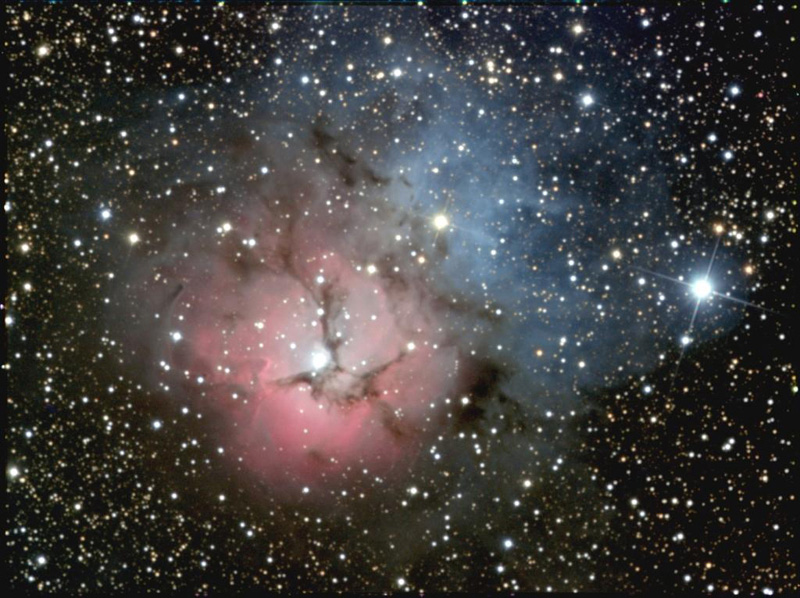

Image Centered on Ra. 18 : 02.6 (h:m) Dec. -23 : 02 (deg:m) Distance 5200 Ly
Diffuse Nebula M20 (NGC 6514), an emission and reflection nebula, in Sagittarius
Information (From the Seds online website)
Discovered by Charles
Messier in 1764.
Charles Messier discovered this object on June 5, 1764, and described it as a
cluster of stars of 8th to 9th magnitude, enveloped in nebulosity.
The Trifid Nebula M20 is famous for its three-lobed appearance. This may have
caused William Herschel, who normally carefully avoided to number Messier's
objects in his catalog, to assign four different numbers to parts of this
nebula: H IV.41 (cataloged May 26, 1786) and H V.10, H V.11, H V.12 (dated July
12, 1784). That he numbered this object at all may have its reason in the fact
that Messier merely described it as 'Cluster of Stars.' The name 'Trifid' was
first used by John Herschel to describe this nebula.
The dark nebula which is the reason for the Trifid's appearance was cataloged by
Barnard as Barnard 85 (B 85).
The red emission nebula with its young star cluster near its center is
surrounded by a blue reflection nebula which is particularly conspicuous to the
northern end. The nebula's distance is rather uncertain, with values between
2,200 light years (Mallas/Kreimer; Glyn Jones has 2,300) and about 7,600 light
years (C.R. O'Dell 1963). The Sky Catalog 2000 gives 5,200 light years, the
WEBDA database has 3140, the Hubble Press Release of Jeff Hester
(STScI-PRC99-42) gives "about 9000" light years.
As often for nebulae, magnitude estimates spread widely: Kenneth Glyn Jones
gives 9.0, while Machholz has estimated 6.8 mag. This may partly come from the
fact that the exciting star, ADS 10991, is a triple system of 7th integrated
magnitude (with components A: 7.6, B: 10.7, C: 8.7 mag). All are extremely hot;
component A is of spectral type O5 or O6. The presence of this considerably
bright triplet makes brightness estimates for the nebula difficult.
Optics and Exposure Data
Telescope Vixen R200ss Newtonian reflector
Imager Starlite-Xpress SXV-H9
Mount Losmandy G11 with Gemini Control Electronics.
60 minutes luminance, 20 minutes RGB Via Astronomiks Color filters
Image acquisition using Astroart then aligned and combined with Maxim Dl. Final processing was accomplished using Photoshop Cs
Images Acquired At Blue Canyon California